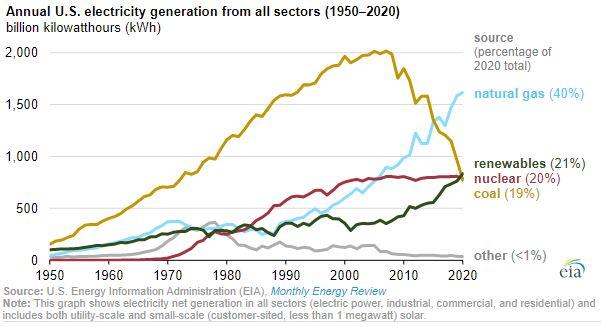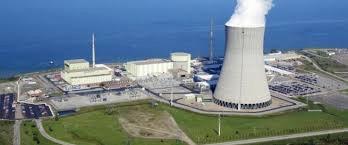 The Clean Power Plan, introduced during the Obama Administration, aimed at reducing carbon dioxide and other emissions from coal-fired power plants. The proposal was opposed by the coal-generation industry with SCOTUS setting aside implementation. In the event, economic forces limited the use of coal as a fuel in favor of natural gas, based on the lower cost to generate electrical power.
The Clean Power Plan, introduced during the Obama Administration, aimed at reducing carbon dioxide and other emissions from coal-fired power plants. The proposal was opposed by the coal-generation industry with SCOTUS setting aside implementation. In the event, economic forces limited the use of coal as a fuel in favor of natural gas, based on the lower cost to generate electrical power.
During the past week SCOTUS ruled 6 to 3 along ideological lines in West Virginia v EPA, confirming that the EPA did not have authority under the Clean Air Act to limit greenhouse gas emissions. In writing for the majority, Chief Justice John Roberts noted, “Capping carbon dioxide emissions at a level that will force a nationwide transition away from the use of coal to generate electricity may be a sensible solution to the crisis of the day but it is not plausible that Congress gave EPA the authority to adopt, on its own, such a regulatory scheme.” In a concurring opinion, Justice Neil Gorsuch noted, “Under the doctrine’s terms administrative agencies must be able to point to clear Congressional authorization when they claim the power to make decisions of vast economic and political significance.”
Writing for the dissent, Justice Elena Kagan responded, “Today the court strips the EPA of the power Congress gave it to respond to the most pressing environmental challenge of our time.”
It is evident from the SCOTUS decision that EPA lacks Congressional authority for wide sweeping regulations. Applying the precedent established by West Virginia v EPA, regulations issued by any government agency may be questioned with regard to whether the intended rules conform to the intent of Congress and whether specific authorization has been provided in the form of legislation. The question devolves into whether agencies with a mix of political and professional management are in a better position to regulate within their jurisdictions or whether intervention (micromanagement?) by Congress should be the deciding factor in developing rules that govern agriculture, health, stock markets, transport and every aspect of the U.S. economy. The SCOTUS decision and its ramifications could be easier to accept if Congress was less deadlocked and able to function expeditiously in a non-partisan mode.
 |
It is evident from the SCOTUS decision that the court recognized the “crisis of the day”. The majority decision however was based on whether agencies have Congressional approval to issue regulations. With respect to the environment, there is no question that man-made greenhouse gas emissions are changing the atmosphere and oceans. Climate change is not a hoax. It is a scientific reality:
- The carbon dioxide content of the atmosphere has increased from approximately 280 ppm at the beginning of the industrial age, rising to 370 ppm in 2000 and attaining 410 ppm in 2020.
- Concurrently, global temperatures have risen since the advent of the industrial era with coal as a major fuel by approximately 0.14 F per decade since 1880. The rate has increased sharply since 2018 to a level of 0.32 F per decade. Average temperatures during 2013 through 2021, included the hottest years on record
- The partial pressure of carbon dioxide in seawater, with oceans serving as both as a temperature and carbon dioxide sink, increased from 325 micro atmospheres in 1985 to 375 micro atmospheres in 2015.
- The pH level of oceans declined from 8.10 to 8.07 from 1985 to 2015. The combination of increased carbon dioxide and higher acidity has affected marine life, including bleaching of corals and has affected the migratory patterns and availability of fish and seafood.
- Sea surface temperature increased approximately 1.0F between 1980 and 2020. Heat stored in the oceans has increased by 18x1027 joules.
- Sea level increased by 10 inches between 1880 and 2020. This has resulted in increased flooding along the East Coast and Gulf with an increase in number of flood days ranging from 5 to 15 over the period 2011 to 2020.
Apart from the irrefutable quantitative measures relating to carbon dioxide and temperature, it is evident that climatic extremes, including hurricanes, floods and droughts have intensified since 2000. The frequency and severity of wildfires on all continents have increased.
 The June 25th edition of The Economist reviewed the necessary transition from reliance on carbon-based generation of power to alternatives. Renewables, including solar and wind, are replacing conventional fossil-fuel generation in many nations despite problems relating to the management of grids receiving power from both controllable generation and from renewables. During mid-afternoon on April 3rd, 97 percent of California’s power was derived from wind and solar. Computerized management of grids is allowing integration of renewable power into extensive systems. The Berlin-based utility, 50-Hertz, is supplying 18 million users in eastern and northern Germany, managing a transmission grid supplied 50 to 60 percent by wind and solar power. The situation in Western Europe is currently complicated by the geopolitical realities arising from the invasion of Ukraine and the need to reduce dependence on oil and gas from Russia.
The June 25th edition of The Economist reviewed the necessary transition from reliance on carbon-based generation of power to alternatives. Renewables, including solar and wind, are replacing conventional fossil-fuel generation in many nations despite problems relating to the management of grids receiving power from both controllable generation and from renewables. During mid-afternoon on April 3rd, 97 percent of California’s power was derived from wind and solar. Computerized management of grids is allowing integration of renewable power into extensive systems. The Berlin-based utility, 50-Hertz, is supplying 18 million users in eastern and northern Germany, managing a transmission grid supplied 50 to 60 percent by wind and solar power. The situation in Western Europe is currently complicated by the geopolitical realities arising from the invasion of Ukraine and the need to reduce dependence on oil and gas from Russia.
Storage is a major restraint to using renewables. Alternative technologies, including advanced batteries, are now technically feasible and economically acceptable for homes and small businesses. More advanced forms of energy storage are under consideration including liquid carbon dioxide and latent heat systems.
 Nuclear generation can be environmentally neutral. It requires capital-intensive installations and long periods for construction and approval. Advances in developing smaller and more efficient plants offer the promise of future reliable power generation, provided the problem of disposal of nuclear waste can be resolved.
Nuclear generation can be environmentally neutral. It requires capital-intensive installations and long periods for construction and approval. Advances in developing smaller and more efficient plants offer the promise of future reliable power generation, provided the problem of disposal of nuclear waste can be resolved.
The oil and gas industry must improve retention of methane, which is released from oil wells and pumping stations. The fact that methane is a highly destructive greenhouse gas should intensify efforts to reduce emissions. Practical solutions offer short-term payback in terms of savings in natural gas released into the atmosphere.
The efficiency of generation from natural gas can be improved by using Allam-cycle technology requiring installations combining a combustor, a turbine, a heat exchanger and compressor.
Hydrogen offers the potential to decarbonize power generation. It is expected that by 2030, hydrogen will be economically competitive with fossil fuels.
During the decade preceding 2020, wind generation capacity increased by four-fold and solar by eighteen-fold. There are currently more jobs in the solar (230,000) and wind (85,000) industries in the U.S than in coal mining (63,000). This reality should be taken into account by legislators representing Appalachia and Wyoming.
If we are to bequeath a livable planet to our grandchildren, we must be realistic with regard to the impact of industry and our lifestyle on the environment. Fortunately, alternative technologies are emerging to transition from traditional fossil fuels and to make abundant U.S. natural gas environmentally more acceptable.
The most recent SCOTUS decision relates to constitutional issues and the relative powers of the Legislative and Executive branches of government. The outcome of West Virginia v EPA is not necessarily a victory for either party, especially over the long term. Let us hope our political leaders, academia and industry will be able to work together to develop practical and economically acceptable alternatives to coal. We must develop solutions that maintain our standard of living without additional environmental degradation.